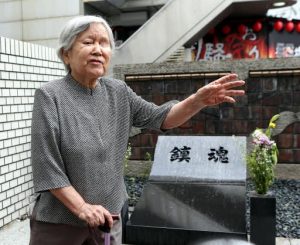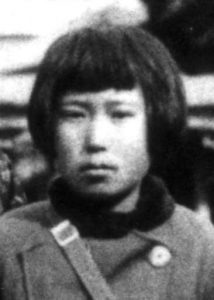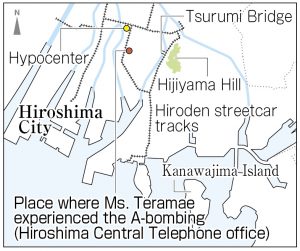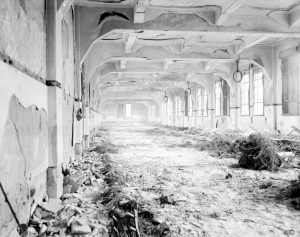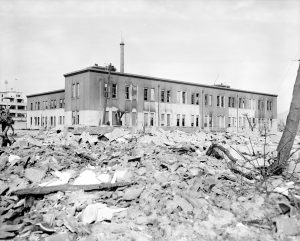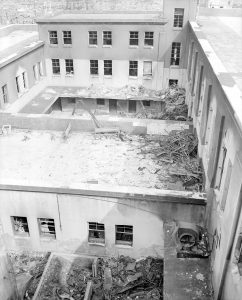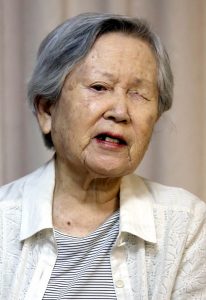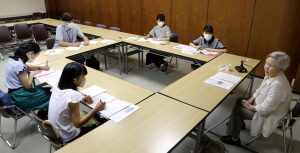Survivors’ Stories: Taeko Teramae, 90, Asaminami Ward, Hiroshima: Overcoming the despair even after losing her left eye
Aug. 3, 2020
by Miho Kuwajima, Staff Writer
Taeko Teramae (née Nakamae), now 90, who experienced the atomic bombing only about 550 meters from the hypocenter and lost her left eye, has spearheaded an A-bomb survivors’ movement since her mid-twenties. She appealed to the public to relay the suffering of those who worked hard and sacrificed their lives for their country and those who became physically disabled because of the atomic bomb.
Working as a telephone operator
Ms. Teramae, who was a third-year student at Shintoku Girls’ High School in August 1945, was mobilized to the Hiroshima Central Telephone office located in Shimonaka-machi (now Fukuro-machi in Naka Ward), and engaged in a telephone exchange service with her classmates. On August 6, she left her home in Kanon village (now part of Saeki Ward) early in the morning and she had already arrived at the office before 8 o’clock.
She chatted with her friends in a resting room and went out to the corridor to return to the telephone exchange room. Suddenly, she was bathed in a blinding flash and the concrete of the ceiling collapsed with a clatter because of the A-bomb blast. She was trapped under rubble in a moment.
When Ms. Teramae managed to struggle out of the rubble, still dumfounded, she suddenly heard a voice from the darkness calling out, “Hang in there! Behave like students!” The voice was coming from Chiyoko Wakida, a teacher in charge of Ms. Teramae’s class. Stirred up by the voice, Ms. Teramae jumped from the window of the second floor and she found that flames were everywhere and people were fleeing desperately.
Flames were approaching. She and her friends headed toward Hijiyama Hill, encouraging each other. and jumped into the Kyobashi River from a place near the Tsurumi Bridge. Her limbs became stiff and it gradually became difficult for her to breathe, but she reached the other side of the river, encouraged by Ms. Wakida’s instruction. Her white gym uniform was stained red with blood. Her left eye was smashed and glass fragments tore her cheeks and chin. After that, she lost consciousness.
When Ms. Teramae came to, she was being taken to Kanawajima Island, located in Hiroshima Bay. Her face was covered with bandages, so she was not able to see anything. There were masses of injured people around her, soldiers and nurses occasionally came to check on her, and she felt helpless every day. About six days later, her father, Akira came to get her. He said, “Taeko. Your father has come.”
It was then that she learned that her favorite sister, Emiko, had died. She was 13 years old and entered First Hiroshima Prefectural Girls’ High School (now Minami High School) in spring. Emiko was helping create fire lanes by dismantling houses and buildings to prevent the spread of fire in the case of air raids in Koami-cho (now part of Naka Ward), about 900 meters from the hypocenter. She was exposed to the bomb’s heat rays under the burning sun, suffered severe burns from head to toe, and passed away in agony the following day. All 280 students in the first year of First Hiroshima Prefectural Girls’ High School, who had been with her, passed away, too.
Ms. Teramae, who had returned to her home, suffered from a high fever over 40 degrees Celsius, and purple spots appeared on her entire body. Her family had put away all the mirrors in the house, but when she looked in the mirror one day, she faced the reality. She said, “Do I have to live with this appearance? I hate the United States. I should have died.”
Committing to relieving A-bomb survivors
Though Ms. Teramae experienced grief and sorrow in her sickbed, she was supported by her parents and began to move forward again. Under the pen name, Kayoko Maki, she wrote, “We don’t want any more A-bomb victims besides us. I’ll live my life, crying for peace,” for a collection of notes, Genbaku ni Ikite (Surviving the A-bombing) edited by the writer, Tomoe Yamashiro, and others in 1953. She joined Atomic Bomb Survivors Association, founded by Takeshi Kawate, who supported the early stages of the movement of A-bomb survivors, Kiyoshi Kikkawa, and the poet Sankichi Toge, and she took her first step to seek relief measures for A-bomb survivors.
Moreover, she worked with people who were injured while helping to tear down homes to create fire lanes and those who lost their children while engaged in their demolition work, and formed the Hiroshima Prefecture Mobilized Student Victims Association in 1957. She became the founding president of the association and petitioned the Diet many times to provide compensation for damage from the Japanese government.
What drove Ms. Teramae to take action, exposing herself in her twenties, without being afraid of discrimination against A-bomb survivors was the fact that the lives of her sister and students in lower grades were suddenly taken away by the atomic bomb. She said, “Many boys and girls, who believed that Japan would win the war, ended up being burned over their entire bodies. If the situation does not change, they virtually died in vain.” She, with other members of the association, collected donations and erected the Memorial Tower to the Mobilized Students in Peace Memorial Park in 1967.
Continuing to fight against disease
Ms. Teramae got married by a happy chance when she was 33 years old. She felt anxious about the aftereffects of her exposure to the atomic bomb given its recency, but she had a healthy boy. She said she had been very happy to know that he was born without any problems. However, Ms. Teramae, who was exposed to thermal rays and a massive amount of radiation from the atomic bombing, has continued to fight disease, including breast cancer and uterine cancer.
She continued to share her A-bomb account for many years but as she turned 90, it has become difficult to do so now. Still, her strong message for the next generation has not changed. She said, “I hope people around the world will be considerate to each other and take a step toward a world without war. Their deaths must not be in vain no matter what.”
I felt sad when I imagined the girl’s horrors
This was my first time listening to a person who experienced the atomic bombing only 550 meters from the hypocenter. Ms. Teramae, then 15, told herself to escape as quickly as possible, and fled with the sole desire of getting away from a razing blaze. I felt very sad when I imagined that a girl who was nearly the same age as I am now got confused in a town like hell and felt its horrors. (Felix Walsh, 18)
I was impressed with her ability to take action
Despite the scars on her face, Ms. Teramae erected a memorial tower for junior high school students and female students who had been killed by the atomic bomb, and took part in a movement seeking compensation for the surviving family members from the Japanese government. I was impressed with her ability to take action and wanted to follow her example. She said, “I hope that the people around the world will all smile.” I accept her words seriously and convey what happened in Hiroshima. (Shino Taguchi, 14)
I was deeply moved by the teacher leading the students
The teacher, who desperately encouraged Ms. Teramae and other students and took them to a relief station, was only 22 years old. I think she was filled with the feeling of saving the students. The teacher must have been scared. When I imagined her, I felt a lump in my throat. Ms. Teramae’s gratitude to the teacher must have been conveyed to her. I felt they have been bound by deep bond. (Riko Soma, 12)
I want to enjoy my school life
Ms. Teramae’s sister, who always had encouraged Ms. Teramae to pull herself together, was killed in the atomic bombing. She was the same first-year junior high school student as I am now. She was gone too soon. As Ms. Teramae could not study or have a dream during the war, she said, “I want young people to enjoy being students.” I’m thankful for the opportunity to study and I want to enjoy my school life. (Misuzu Mori, 13)
I want to convey the preciousness of human lives
Ms. Teramae began to share her A-bomb account because she wanted people to know the damage caused by the atomic bombing, and eliminate discrimination against A-bomb survivors. I took part in this interview for the first time and I learned that Ms. Teramae suffered serious injuries and also suffered from discrimination when she was facing hard times because her sister passed away. I also learned the importance of sharing messages. I want to listen to A-bomb survivors’ stories and convey the cruelty of the atomic bombing and preciousness of human life. (Mayu Yoshida, 13)
(Originally published on August 3, 2020)
Calling for peace after deaths of her sister and other students
Taeko Teramae (née Nakamae), now 90, who experienced the atomic bombing only about 550 meters from the hypocenter and lost her left eye, has spearheaded an A-bomb survivors’ movement since her mid-twenties. She appealed to the public to relay the suffering of those who worked hard and sacrificed their lives for their country and those who became physically disabled because of the atomic bomb.
Working as a telephone operator
Ms. Teramae, who was a third-year student at Shintoku Girls’ High School in August 1945, was mobilized to the Hiroshima Central Telephone office located in Shimonaka-machi (now Fukuro-machi in Naka Ward), and engaged in a telephone exchange service with her classmates. On August 6, she left her home in Kanon village (now part of Saeki Ward) early in the morning and she had already arrived at the office before 8 o’clock.
She chatted with her friends in a resting room and went out to the corridor to return to the telephone exchange room. Suddenly, she was bathed in a blinding flash and the concrete of the ceiling collapsed with a clatter because of the A-bomb blast. She was trapped under rubble in a moment.
When Ms. Teramae managed to struggle out of the rubble, still dumfounded, she suddenly heard a voice from the darkness calling out, “Hang in there! Behave like students!” The voice was coming from Chiyoko Wakida, a teacher in charge of Ms. Teramae’s class. Stirred up by the voice, Ms. Teramae jumped from the window of the second floor and she found that flames were everywhere and people were fleeing desperately.
Flames were approaching. She and her friends headed toward Hijiyama Hill, encouraging each other. and jumped into the Kyobashi River from a place near the Tsurumi Bridge. Her limbs became stiff and it gradually became difficult for her to breathe, but she reached the other side of the river, encouraged by Ms. Wakida’s instruction. Her white gym uniform was stained red with blood. Her left eye was smashed and glass fragments tore her cheeks and chin. After that, she lost consciousness.
When Ms. Teramae came to, she was being taken to Kanawajima Island, located in Hiroshima Bay. Her face was covered with bandages, so she was not able to see anything. There were masses of injured people around her, soldiers and nurses occasionally came to check on her, and she felt helpless every day. About six days later, her father, Akira came to get her. He said, “Taeko. Your father has come.”
It was then that she learned that her favorite sister, Emiko, had died. She was 13 years old and entered First Hiroshima Prefectural Girls’ High School (now Minami High School) in spring. Emiko was helping create fire lanes by dismantling houses and buildings to prevent the spread of fire in the case of air raids in Koami-cho (now part of Naka Ward), about 900 meters from the hypocenter. She was exposed to the bomb’s heat rays under the burning sun, suffered severe burns from head to toe, and passed away in agony the following day. All 280 students in the first year of First Hiroshima Prefectural Girls’ High School, who had been with her, passed away, too.
Ms. Teramae, who had returned to her home, suffered from a high fever over 40 degrees Celsius, and purple spots appeared on her entire body. Her family had put away all the mirrors in the house, but when she looked in the mirror one day, she faced the reality. She said, “Do I have to live with this appearance? I hate the United States. I should have died.”
Committing to relieving A-bomb survivors
Though Ms. Teramae experienced grief and sorrow in her sickbed, she was supported by her parents and began to move forward again. Under the pen name, Kayoko Maki, she wrote, “We don’t want any more A-bomb victims besides us. I’ll live my life, crying for peace,” for a collection of notes, Genbaku ni Ikite (Surviving the A-bombing) edited by the writer, Tomoe Yamashiro, and others in 1953. She joined Atomic Bomb Survivors Association, founded by Takeshi Kawate, who supported the early stages of the movement of A-bomb survivors, Kiyoshi Kikkawa, and the poet Sankichi Toge, and she took her first step to seek relief measures for A-bomb survivors.
Moreover, she worked with people who were injured while helping to tear down homes to create fire lanes and those who lost their children while engaged in their demolition work, and formed the Hiroshima Prefecture Mobilized Student Victims Association in 1957. She became the founding president of the association and petitioned the Diet many times to provide compensation for damage from the Japanese government.
What drove Ms. Teramae to take action, exposing herself in her twenties, without being afraid of discrimination against A-bomb survivors was the fact that the lives of her sister and students in lower grades were suddenly taken away by the atomic bomb. She said, “Many boys and girls, who believed that Japan would win the war, ended up being burned over their entire bodies. If the situation does not change, they virtually died in vain.” She, with other members of the association, collected donations and erected the Memorial Tower to the Mobilized Students in Peace Memorial Park in 1967.
Continuing to fight against disease
Ms. Teramae got married by a happy chance when she was 33 years old. She felt anxious about the aftereffects of her exposure to the atomic bomb given its recency, but she had a healthy boy. She said she had been very happy to know that he was born without any problems. However, Ms. Teramae, who was exposed to thermal rays and a massive amount of radiation from the atomic bombing, has continued to fight disease, including breast cancer and uterine cancer.
She continued to share her A-bomb account for many years but as she turned 90, it has become difficult to do so now. Still, her strong message for the next generation has not changed. She said, “I hope people around the world will be considerate to each other and take a step toward a world without war. Their deaths must not be in vain no matter what.”
Teenagers’ Impressions
I felt sad when I imagined the girl’s horrors
This was my first time listening to a person who experienced the atomic bombing only 550 meters from the hypocenter. Ms. Teramae, then 15, told herself to escape as quickly as possible, and fled with the sole desire of getting away from a razing blaze. I felt very sad when I imagined that a girl who was nearly the same age as I am now got confused in a town like hell and felt its horrors. (Felix Walsh, 18)
I was impressed with her ability to take action
Despite the scars on her face, Ms. Teramae erected a memorial tower for junior high school students and female students who had been killed by the atomic bomb, and took part in a movement seeking compensation for the surviving family members from the Japanese government. I was impressed with her ability to take action and wanted to follow her example. She said, “I hope that the people around the world will all smile.” I accept her words seriously and convey what happened in Hiroshima. (Shino Taguchi, 14)
I was deeply moved by the teacher leading the students
The teacher, who desperately encouraged Ms. Teramae and other students and took them to a relief station, was only 22 years old. I think she was filled with the feeling of saving the students. The teacher must have been scared. When I imagined her, I felt a lump in my throat. Ms. Teramae’s gratitude to the teacher must have been conveyed to her. I felt they have been bound by deep bond. (Riko Soma, 12)
I want to enjoy my school life
Ms. Teramae’s sister, who always had encouraged Ms. Teramae to pull herself together, was killed in the atomic bombing. She was the same first-year junior high school student as I am now. She was gone too soon. As Ms. Teramae could not study or have a dream during the war, she said, “I want young people to enjoy being students.” I’m thankful for the opportunity to study and I want to enjoy my school life. (Misuzu Mori, 13)
I want to convey the preciousness of human lives
Ms. Teramae began to share her A-bomb account because she wanted people to know the damage caused by the atomic bombing, and eliminate discrimination against A-bomb survivors. I took part in this interview for the first time and I learned that Ms. Teramae suffered serious injuries and also suffered from discrimination when she was facing hard times because her sister passed away. I also learned the importance of sharing messages. I want to listen to A-bomb survivors’ stories and convey the cruelty of the atomic bombing and preciousness of human life. (Mayu Yoshida, 13)
(Originally published on August 3, 2020)

